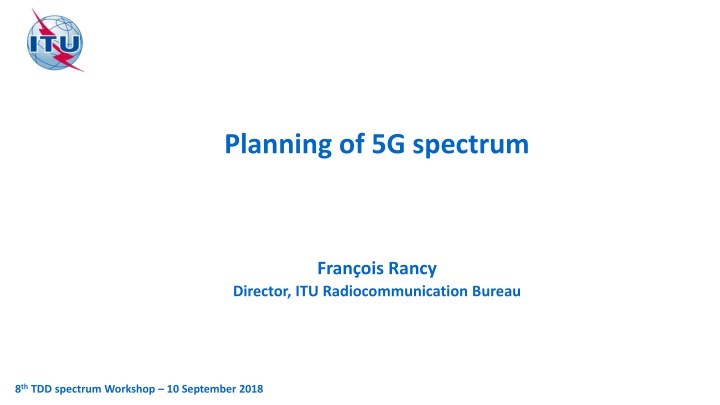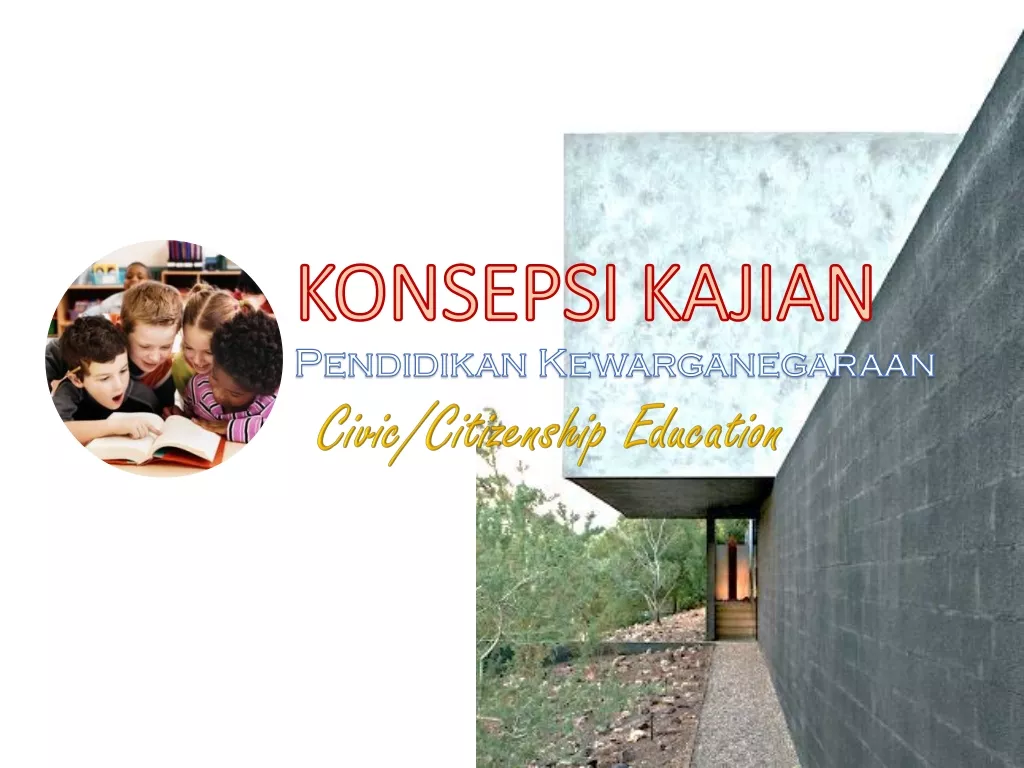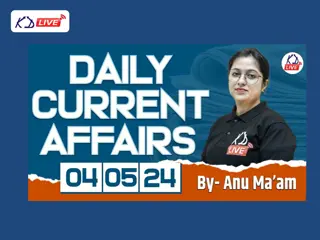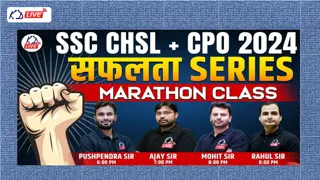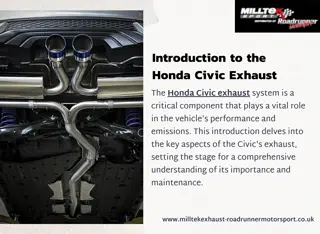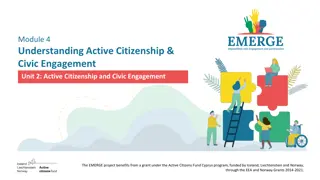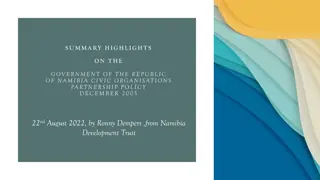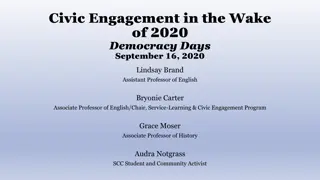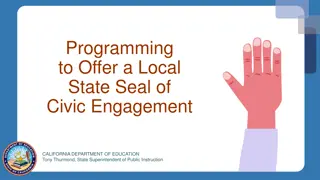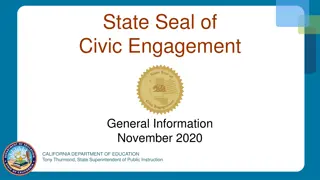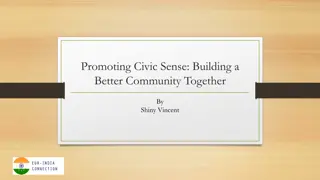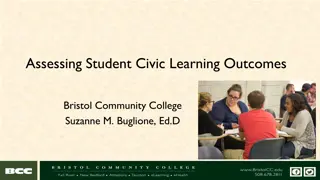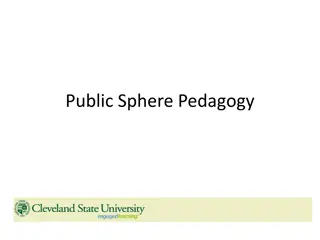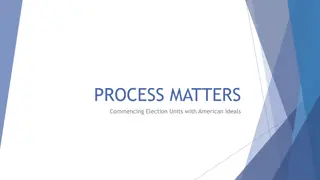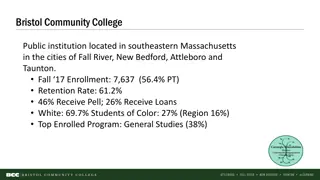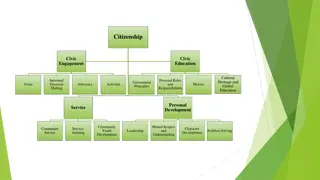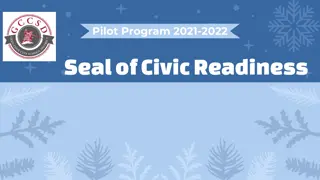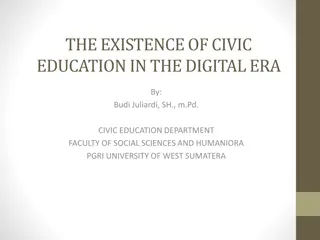Assessing Impacts of Civic Learning Courses
Evaluating the effects of civic learning courses on students, assess required skills and values for civic participation, and utilize rubrics to gauge student learning in civic knowledge and values.
Download Presentation

Please find below an Image/Link to download the presentation.
The content on the website is provided AS IS for your information and personal use only. It may not be sold, licensed, or shared on other websites without obtaining consent from the author.If you encounter any issues during the download, it is possible that the publisher has removed the file from their server.
You are allowed to download the files provided on this website for personal or commercial use, subject to the condition that they are used lawfully. All files are the property of their respective owners.
The content on the website is provided AS IS for your information and personal use only. It may not be sold, licensed, or shared on other websites without obtaining consent from the author.
E N D
Presentation Transcript
Planning of 5G spectrum Fran ois Rancy Director, ITU Radiocommunication Bureau 8th TDD spectrum Workshop 10 September 2018
DRAFT FINANCIAL PLAN DRAFT FINANCIAL PLAN 2020 Both require global collaboration 2020 - - 2023 2023 Spectrum Standards January 2018Both need to be globally harmonized FP FP 2020 2020- -2023 2023 - - January 2018
Spectrum Standards ITU WRC Process Mobile spectrum allocations and IMT identifications ITU membership, ITU-R Study Groups, Regional Groups, International organisations Member States driven ITU-R Study Group 5 Process IMT-2020 Vision, overall requirements, radio interface specifications ITU membership, other standard making bodies Industry driven Reports & Recommendations approved by Member States FP FP 2020 2020- -2023 2023 - - January 2018 January 2018
IMT IMT- -2020 2020 standardization process standardization process Technical performance requirements Evaluation criteria Invitation for proposals Sharing study parameters (IMT-2020) Sharing studies in preparation for WRC-19 Spectrum/band arrangements Decision & radio framework Detailed IMT-2020 radio specifications Future enhancement/ update plan & process Development plan Market/services view Technology/ research kick off Vision - IMT for 2020 Name Process optimization Technical proposals Evaluation Groups Methodology Consensus building IMT IMT- -2020 spectrum allocation process 2020 spectrum allocation process < 6 GHz Spectrum view ITU-R Study Group activities/studies Spectrum/band arrangements (post WRC-15) CPM Report (IMT- WRC-19) Sharing study reports Spectrum/band arrangements (WRC-19) 2018-2019 2019-2020 2012-2015 2016-2017 Setting the stage for the future: vision, spectrum, and technology views Defining the technology Allocate the spectrum
Usage scenarios of IMT for 2020 and beyond Enhanced Mobile Broadband High traffic capacity, high peak data rate, high user data rate Above 24 GHz (WRC-19) Gigabytes in a second 3D video, UHD screens Work and play in the cloud Smart Home/Building Augmented reality Bridging coverage, capacity, mobility, data rate, spectrum efficiency 1 GHz to 6 GHz Industry automation Mission critical application, e.g. e-health Voice Smart City Self Driving Car Future IMT Coverage, mobility, connection density, improved data rate, spectrum efficiency Below 1 GHz Massive Machine Type Communications Ultra-reliable and Low Latency Communications
WRC-19 AI 1.13 objectives for sharing & compatibility studies 24.25 GHz Incumbent services Mobile-satellite Radionavigation-satellite Fixed-satellite Broadcasting-satellite Radio astronomy Space research Earth exploration-satellite Inter-satellite Earth exploration-satellite (passive) Space research (passive) Fixed Mobile (Multiple gigabit wireless systems) Aeronautical mobile Radiodetermination Selected frequency bands Focus on 24.25 27.5 GHz Mobile service IMT-2020 37 43.5 GHz 66 86 GHz 86 GHz
WRC-19 AI 1.13 outcome of ITU-R sharing & compatibility studies Frequency range (GHz) Most limiting incumbent service Sharing conditions Potential spectrum for IMT-2020 24.25-27.5 Unwanted emission limits Meteorology satellite 31.8-33.4 Large separation distances Airborne radars 37-43.5 42.5-43.5 45.5-47 & 47- 47.2 47.2-50.2 50.4-52.6 66-71 71-76 81-86 Unwanted emission limits Sharing feasible Meteorology satellite Fixed satellite No sharing studies - Unwanted emission limits Unwanted emission limits Sharing feasible Unwanted emission limits Unwanted emission limits Meteorology satellite Meteorology satellite Mobile satellite Automotive radars Automotive radars
